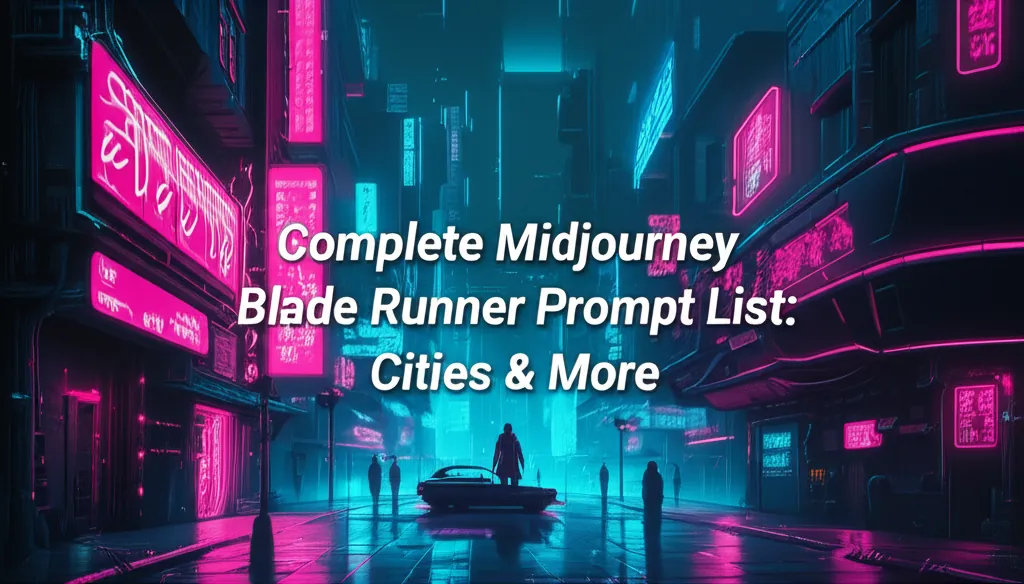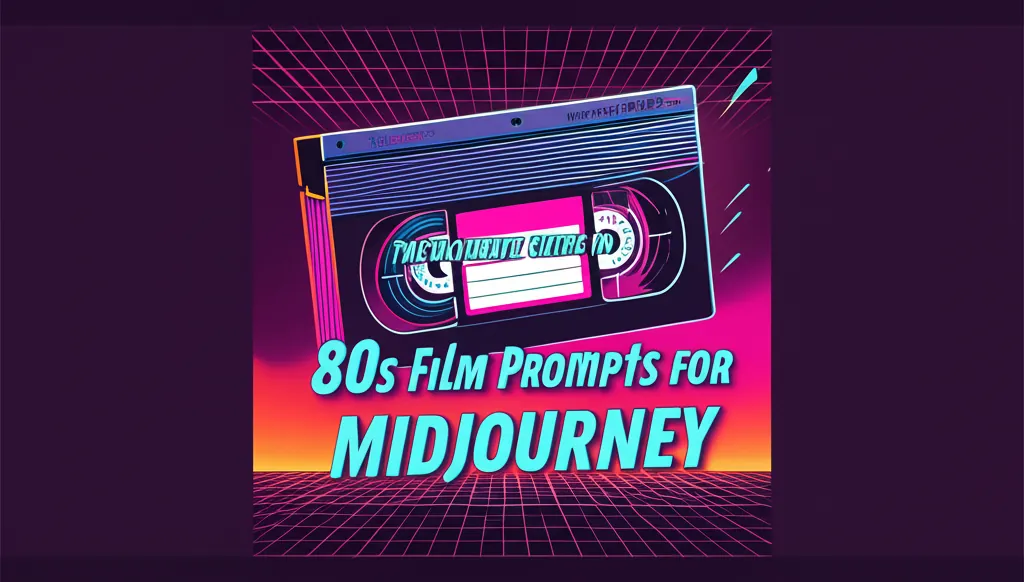Developer Offer
Try ImaginePro API with 50 Free Credits
Build and ship AI-powered visuals with Midjourney, Flux, and more — free credits refresh every month.
Cyberpunk & Blade Runner Midjourney Prompts: Dev & Design Guide
Cyberpunk & Blade Runner Midjourney Prompts: Dev & Design Guide
This guide breaks down the essential techniques and provides ready-to-use prompts for developers and designers to master the iconic Blade Runner aesthetic in Midjourney.
The world of Blade Runner is more than just a setting; it's a feeling. It’s the perpetual rain on neon-drenched streets, the oppressive scale of megastructures piercing a polluted sky, and the quiet melancholy of a future that feels both technologically advanced and deeply decayed. This distinct "neon-noir" or cyberpunk aesthetic has captivated audiences for decades. For developers and designers using AI image generation, recreating this complex atmosphere is a significant creative challenge.
This guide is your comprehensive manual for conquering that challenge. We'll move beyond simple prompts and teach you the repeatable formula for generating stunning Blade Runner-style art with Midjourney. You will learn how to control the atmosphere, compose cinematic shots, design characters and environments, and leverage advanced V6 features to bring your dystopian visions to life.
The "Blade Runner" Prompt Formula: Key Ingredients
Crafting a successful cyberpunk Midjourney prompt isn't about finding a single "magic" phrase. It's about layering specific instructions that guide the AI toward your desired outcome. A great prompt acts like a creative brief for the model, and for the Blade Runner look, it contains several core components.
A powerful base formula to start with is:
[SUBJECT] + [STYLE/AESTHETIC] + [ATMOSPHERE & LIGHTING] + [COMPOSITION & CAMERA] + [PARAMETERS]
Let's break down this structure with a practical example. Imagine we want to create a classic street-level scene.
Prompt Anatomy Example:
a lone figure in a trench coat walks down a crowded street- [SUBJECT]in the dystopian cyberpunk style of Blade Runner 2049- [STYLE/AESTHETIC]moody, dense fog, towering holographic billboards, neon reflections on wet asphalt- [ATMOSPHERE & LIGHTING]cinematic, wide angle shot, 85mm lens, film grain- [COMPOSITION & CAMERA]--ar 16:9 --style raw --v 6.0- [PARAMETERS]
Each part of this prompt gives Midjourney a crucial piece of information, layering details to build a rich, coherent image that screams "Blade Runner."
Master the Atmosphere: How to Get the Rainy, Neon-Noir Look
The soul of the Blade Runner aesthetic is its atmosphere. Getting this right is the most critical step. It’s a combination of weather, light, and framing that creates the signature mood.
Prompting for Rain, Fog, and Wet Reflections
The environment in Blade Runner is a character in itself. It’s perpetually damp, hazy, and reflective. To capture this, use descriptive keywords that evoke a sense of a world saturated with moisture and pollution.
- For Rain:
rain-slicked streets,drizzling rain,downpour,wet asphalt,glistening pavement. - For Fog & Haze:
dense fog,thick smog,atmospheric haze,polluted air,low-hanging clouds. - For Reflections:
reflections in puddles,neon glow reflected on wet surfaces,gleaming chrome.
Example Prompt Fragment:
...a futuristic cityscape at night, dense fog rolling through the streets, neon signs reflecting off the wet asphalt...
Keywords for Cinematic Lighting & Neon Glow
Lighting is what separates a generic sci-fi scene from a true neon-noir masterpiece. The lighting is high-contrast, often coming from diegetic sources like signs and headlights, creating deep shadows and vibrant highlights.
- Key Lighting Terms:
cinematic lighting,volumetric lighting(for light beams in fog),dramatic lighting,noir lighting,rim lighting(to outline subjects). - Neon & Holograms:
towering holographic billboards,glowing neon signs,flickering kanji signs,vibrant neon glow. - Camera Effects:
anamorphic lens flare,subtle lens flare,film grain,bokeh.
Using Aspect Ratio for a Cinematic Feel
Most films, including the Blade Runner series, are shot in a widescreen format. By default, Midjourney creates square images (--ar 1:1). To instantly give your creations a more cinematic quality, you must change the aspect ratio.
--ar 16:9: Standard widescreen, perfect for most scenes.--ar 21:9or--ar 2.39:1: Ultrawide or "CinemaScope" format for epic, sweeping cityscapes.
You can find a full list of parameters in the official Midjourney documentation.
Prompt Gallery: 20+ Copy-and-Paste Blade Runner Prompts
Here is a gallery of ready-to-use cyberpunk Midjourney prompts. Use these as a starting point and feel free to modify and combine them.
(Imagine a high-quality, generated image above each prompt)
Prompts for Cyberpunk Cityscapes & Megastructures
This is a core pillar of any midjourney environment design prompt for this style. Focus on scale, pollution, and the blend of decay and high-tech.
-
a sprawling midjourney cyberpunk city at night, colossal brutalist megastructures disappear into the thick smog, flying vehicles weave between buildings, in the style of Blade Runner, cinematic lighting, moody, atmospheric --ar 16:9 --style raw --v 6.0 -
street-level view of a dystopian city alley, steam rising from vents, piles of futuristic junk, flickering neon noodle bar sign in Japanese, moody and gritty, photorealistic --ar 4:5 --v 6.0 -
the top of a massive skyscraper overlooking a neon-drenched futuristic Los Angeles, endless city lights through a dense hazy atmosphere, cinematic, style of Syd Mead --ar 21:9 --v 6.0 -
a vast, monolithic Tyrell Corporation-style pyramid dominating a polluted city skyline at sunset, orange and purple haze, volumetric lighting --ar 16:9 --v 6.0
Prompts for Replicant-Style Character Portraits
Characters should feel integrated into their world—often weary, contemplative, and defined by the harsh lighting around them.
-
cinematic portrait of a female replicant with glowing eyes, rain running down her face, neon signs reflected in her leather jacket, noir film style, moody, hyper-detailed --ar 4:5 --v 6.0 -
full-body shot of a grizzled blade runner detective in a long trench coat, standing in a crowded, rainy market, looking off-camera, shallow depth of field, anamorphic lens flare --ar 16:9 --style raw --v 6.0 -
close-up on a pensive android's face, synthetic skin, intricate cybernetic details visible, soft neon glow from the side, style of Blade Runner 2049, extremely detailed --ar 1:1 --v 6.0 -
a mysterious figure in a dark hooded cloak, silhouetted against a massive holographic advertisement in a cyberpunk city, dramatic noir lighting --ar 16:9 --v 6.0
Prompts for Futuristic Vehicles (Spinners)
Vehicles are an essential part of the world's design, blending functional and futuristic elements.
-
a police "Spinner" vehicle hovering in a foggy alleyway, headlights cutting through the haze, rain beading on the windshield, cinematic, photorealistic, gritty details --ar 16:9 --v 6.0 -
a line of futuristic traffic on a multi-level highway in a cyberpunk megacity, streaks of light from headlights and taillights, motion blur, long exposure photography style --ar 21:9 --v 6.0 -
an abandoned, rust-covered flying car crashed in a desolate industrial wasteland, acid rain falling, dystopian and lonely mood --ar 16:9 --v 6.0
Prompts for Interior Scenes (Deckard's Apartment Style)
Interiors contrast the chaotic city with moments of quiet. They are often defined by shadow, texture, and single, dramatic light sources.
-
interior of a cluttered, futuristic apartment, light streaming through venetian blinds casting long shadows, a glass of whiskey on a table, film noir atmosphere, style of Deckard's apartment --ar 16:9 --v 6.0 -
a high-tech laboratory filled with esoteric equipment and holographic displays, sterile environment with cold, blue lighting, cinematic, clean and minimalist cyberpunk aesthetic --ar 16:9 --v 6.0 -
the inside of a crowded, off-world cantina, diverse alien and human patrons, hazy with smoke, lit by lanterns and neon signs, moody and atmospheric --ar 16:9 --v 6.0
Advanced Techniques for Designers & Developers
To truly elevate your creations, you need to go beyond basic prompting. Here are some advanced techniques for designers & developers using Midjourney V6.
Referencing Syd Mead: The "Visual Futurist"
Syd Mead was the legendary designer and "visual futurist" whose concept art defined the look of the original Blade Runner. To channel his unique style, which blends organic curves with massive industrial forms, simply add in the style of Syd Mead or concept art by Syd Mead to your prompt. This tells Midjourney to reference his specific design language.
Using –sref and –cref for Consistency
Midjourney V6 introduced powerful new tools for consistency:
- Style Reference (
--sref <image_url>): If you generate an image with a perfect atmosphere, you can use its URL as a style reference. Midjourney will then apply that same "style" (color, lighting, mood) to a new prompt. This is invaluable for creating a cohesive series of images. - Character Reference (
--cref <image_url>): Similarly, you can use an image of a character to maintain their appearance across different scenes. This is a game-changer for storytelling and character design.
For developers looking to automate these advanced workflows, such as programmatically generating character sheets or environment concepts, using an API is the next logical step. Platforms like imaginepro.ai provide API access to models like Midjourney, allowing you to integrate these powerful generation capabilities directly into your applications, bypassing the Discord interface for more streamlined and scalable content creation.
Which Midjourney Version is Best for the Blade Runner Look?
Midjourney V6 is, without question, the best version for this aesthetic. Its significantly improved natural language understanding means it follows complex, layered prompts (like our formula) with much greater accuracy. Furthermore, its enhanced realism, lighting models, and handling of fine details like rain and reflections are essential for achieving a believable neon-noir look.
Blade Runner Prompt FAQ
Here are direct answers to some of the most common questions about creating this style in Midjourney.
What is the best prompt for a Blade Runner style in Midjourney?
There is no single "best" prompt, but a powerful and reliable template is: cinematic film still of [YOUR SCENE], in the dystopian neon-noir style of Blade Runner, atmospheric, volumetric lighting, dense fog, rain-slicked streets, anamorphic lens flare, film grain --ar 16:9 --v 6.0. Replace [YOUR SCENE] with your subject.
How do you create a Blade Runner city in Midjourney?
To create a midjourney cyberpunk city, focus on keywords that convey immense scale and a mix of high-tech and urban decay. Use phrases like colossal megastructures, sprawling futuristic metropolis, thick industrial smog, flying vehicle traffic, towering holographic advertisements, and in the style of Syd Mead. Always use a widescreen aspect ratio like --ar 16:9 or --ar 21:9.
What are the key terms for a neon noir Midjourney prompt?
The essential terms are: neon-noir, cinematic lighting, volumetric lighting, atmospheric, moody, high contrast, deep shadows, rain, fog, wet reflections, and anamorphic lens flare. Combining these will consistently produce the desired look.
How do you get the rainy, atmospheric look of Blade Runner in AI?
Use a combination of specific weather and atmospheric keywords. Start with a base of rainy night or dense fog. Then, add detail with phrases like rain-slicked asphalt, droplets on glass, steam from vents, and reflections in puddles. Pairing these with lighting keywords like volumetric lighting will make light beams visible in the rain and fog, completing the effect.
Conclusion
Mastering the Blade Runner aesthetic in Midjourney is an art of precision and layering. By understanding the core formula—Subject, Style, Atmosphere, Lighting, Composition, and Parameters—you move from a passive user to an active director of the AI. You can now dictate the weather, control the light, and frame your shots with cinematic intent.
The prompts and techniques in this guide are your foundation. The true potential is unlocked through experimentation. Change one keyword, swap out a camera lens, or use --sref to blend the mood of one image with the subject of another. The rain-soaked, neon-lit streets are yours to create. Now go build your world.
Compare Plans & Pricing
Find the plan that matches your workload and unlock full access to ImaginePro.
| Plan | Price | Highlights |
|---|---|---|
| Standard | $8 / month |
|
| Premium | $20 / month |
|
Need custom terms? Talk to us to tailor credits, rate limits, or deployment options.
View All Pricing Details

